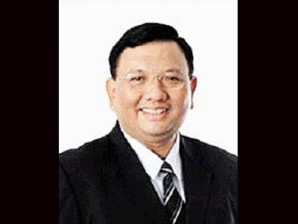
Secretary to the Cabinet Jose Rene D. Almendras. FILE PHOTO
MANILA, Philippines—President Benigno Aquino III has given Cabinet Secretary Rene Jose Almendras a powerful role in his administrations as implementor of its projects roadmap, without clipping the powers of Executive Secretary Paquito Ochoa Jr.
The President signed Executive Order 99 on Oct. 31 vesting the Cabinet Secretary with powers to implement his 16-point agenda and Philippine Development Plan between now and June 2016, when he steps down from power.
The secretary will report directly to the President, and will hold office in Malacañang, Abigail Valte, one of the President’s official spokespersons, said at a Palace news briefing.
“If you look at everything that the Executive Secretary is doing, it’s quite heavy. There are instructions given by the President on a day-to-day basis to his Cabinet secretaries that need to be monitored just to make sure. Secretary Almendras will be that person,’’ Valte addeed.
Before flying on Sunday afternoon to Laos to attend the 9th Asia-Europe Meeting, Aquino administered the oaths of office to Almendras and new Energy Secretary Jericho Petilla at the Ninoy Aquino International Airport. Almendras was the previous energy secretary.
Under the EO, the Cabinet Secretary’s main job is to facilitate the identification of a list of priority areas and outcome-based targets in the President’s “social contract’’ or 16-point agenda, and the Philippine Development Plan from now until 2016. The plan translates the administration’s medium-term priorities into specific programs and projects.
“The Cabinet Secretary will be in charge of monitoring and making sure that the projects under the roadmap will be implemented on time,’’ Valte said.
According to the EO, his other functions are to:
• Recommend to the President an annual detailed and measurable performance and projects roadmap that will facilitate outputs of the targets against priorities, in close coordination with the concerned agencies;
• Ensure the timely execution and monitor the significant impact of the targets under the annual performance and projects roadmap, and re-align targets when needed;
• Represent the President in meetings and such other fora in order to expedite inter-agency action toward the achievement of the targets identified in the performance and projects roadmap;
• Assist in providing timely and organized information to the Cabinet on issues and problems submitted for decision and action; and
• Perform such other functions as may be necessary and incidental to the attainment of its objectives or as may be assigned by the President.
On top of these, the Cabinet Secretary will also chair the Inter-Agency Task Force to oversee and integrate the Results-Based Performance Management System across all agencies. The Executive Secretary will co-chair the task force.
The Cabinet Secretary is also a member of all Cabinet clusters, and the National Economic and Development Authority Board Executive Committee, and other NEDA committees.
But by giving Almendras such powers, the President did not clip the powers of the otherwise low-profile Ochoa, according to Valte.
“Well, your Executive Secretary is still what we call ‘primus inter pares’,’’ she said. “Whatever the ES was doing before, it will stay.”
Some functions of Presidential Management Staff chief Julia Abad were transferred to the Cabinet Secretary, she said.
Some political analysts observed that Almendras’ appointment would diminish Ochoa’s role in the Executive Department.
In essence, the EO reconstitutes the Office of the Cabinet Secretariat of 1986 and renames it Office of the Cabinet Secretary, defining its powers, and providing support staff.
To avoid confusion, the Presidential Communication Development and Strategic Planning Office released a matrix delineating the functions of the Cabinet Secretary, the Executive Secretary and the PMS head.
The matrix shows that the Cabinet Secretary’s mandate has to do with policy: integration and implementation of the programs of the administrations.
The Executive Secretary’s mandate is administrative in nature since he responds to the “specific needs and requirements’’ of the President. The PMS head is directly responsible for providing staff assistance in the president’s exercise of overall management of the development process, the strategic planning office said.
Based on the matrix, the Cabinet Secretary’s powers and functions are limited to six, compared with a long list of functions of the Executive Secretary and the PMS head.
But EO 99 also transfers the functions of the Inter-Agency Task Force to the Cabinet Secretary. Created by Administrative Order No. 25, the task force is tasked with carrying out harmonizing, unifying, streamlining and reporting requirements and processes consistent with the Results-Based Performance Management System, which spells out a performance-based incentive system for government employees.
Almendras will chair the inter-agency task force. Ochoa will co-chair it. The PMS head is a member.
“`There is a need to operationalize the outputs of the Inter-Agency Task Force created under AO 25 to strengthen and more closely monitor the delivery of the identified targets to ensure that these translate into outcomes that directly and positively impact on the lives of the Filipino people,’’ the President said in EO 99.
Almendras will also be a member of Neda’s Investment Coordination Committee, Social Development Committee and Infrastructure Committee.
According to EO 99, the Cabinet Secretary will be under the control and supervision of the President, and will report directly to him.